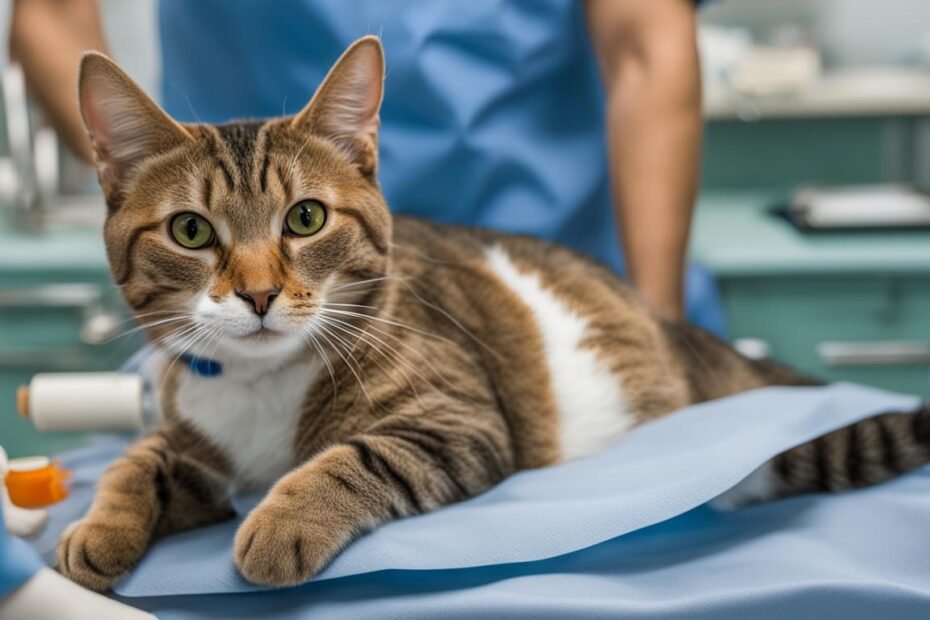Welcome to the complete guide to cat spaying and neutering! If you’re a cat owner, considering spaying or neutering your furry friend is a responsible decision that can benefit both your cat’s health and the community. In this guide, we’ll walk you through the process, the benefits, when to do it, and how to care for your cat post-surgery. So let’s get started on this important journey!
Before we dive into the details, let’s take a look at what you can expect when it comes to cat spaying and neutering. From preventing unplanned litters to eliminating hormonally linked behavioral issues, this procedure has numerous advantages for your cat’s well-being. It’s important to note that the best time to spay or neuter your cat is usually between 4 to 6 months of age, but consult with your vet to determine the most suitable timing for your furry friend.
Key Takeaways:
- Spaying and neutering cats is crucial for population control and has health and behavioral benefits for your cat.
- It is recommended to spay or neuter your cat between 4 to 6 months of age.
- Spaying or neutering your cat helps prevent pregnancy and eliminates hormonally linked behavioral issues.
- Spaying reduces the risk of mammary and uterine cancers, while neutering reduces roaming, fighting, and urine spraying in male cats.
- The procedures are typically performed as outpatient surgeries under general anesthesia.
Benefits of Spaying/Neutering Cats
Spaying or neutering your cat provides numerous benefits that contribute to their overall well-being. Here are some of the key advantages of getting your cat spayed or neutered:
Population Control
One of the primary benefits of spaying or neutering your cat is controlling the cat population. By preventing unplanned litters, you can help reduce the number of stray and feral cats in your community. This, in turn, helps prevent overcrowding in shelters and reduces the risk of cats being euthanized due to a lack of homes.
Health Benefits for Female Cats
Spaying female cats helps reduce the risk of certain health issues. It significantly lowers the chances of developing mammary and uterine cancers, as well as uterine infections. Spaying also eliminates the heat cycle in female cats, which can be stressful for both the cat and their owner.
Behavioral Benefits for Male Cats
Neutering male cats can have positive effects on their behavior. It reduces the urge to roam in search of mates, which can lead to them getting into fights with other cats and being at risk of injuries or contracting diseases. Neutering also helps decrease urine spraying, which is a common marking behavior in intact male cats.
By spaying or neutering your cat, you can improve their overall health, reduce the risk of certain diseases, and prevent unwanted behaviors. It’s a responsible decision that not only benefits your cat but also helps contribute to a healthier and more balanced cat population.

When to Spay/Neuter Cats
Deciding when to spay or neuter your cat is an important consideration for responsible pet owners. The optimal time for the procedure is usually between 4 to 6 months of age. This is when cats can become sexually mature and can potentially get pregnant or impregnate other cats. Spaying or neutering at an earlier age, around 4 months, is generally safe and recommended by many veterinarians.
The decision on the timing of spaying or neutering may vary slightly between vets, so it’s important to consult with your veterinarian and consider your cat’s individual case. They will be able to assess your cat’s overall health and development and provide guidance based on their professional expertise.
It’s worth noting that indoor-only kittens can wait until 6 months to be spayed or neutered, as there is no risk of pregnancy. However, it’s still important to spay or neuter them to prevent any accidental escapes and reduce the chances of hormonal-related behavior issues.
| Age | Benefits | Considerations |
|---|---|---|
| 4-6 months |
|
|
| 6 months and older |
|
|
As a responsible pet owner, ensuring the well-being of your cat includes making informed decisions about spaying or neutering. By spaying or neutering your cat at the recommended time, you can contribute to population control efforts and provide your cat with numerous health and behavioral benefits.
Spaying and Neutering Procedures
Spaying and neutering are common surgical procedures that are performed to control the cat population and provide various health benefits for your furry friend. Let’s take a closer look at what these procedures involve.
The Spaying Procedure
Spaying, also known as an ovariohysterectomy, is the surgical removal of a female cat’s ovaries and uterus. It is typically performed under general anesthesia. The incision is made on the cat’s abdomen, and the reproductive organs are carefully removed. Stitches may be used to close the incision, and a small cone or Elizabethan collar may be necessary to prevent your cat from licking or chewing the area.

The Neutering Procedure
Neutering, also known as castration, involves the surgical removal of a male cat’s testicles. Like spaying, it is performed under general anesthesia. An incision is made on the scrotum, and the testicles are removed. In most cases, male cats do not require stitches. However, the incision may be closed with sutures if deemed necessary by the veterinarian.
Recovery and Postoperative Care
After the spaying or neutering procedure, it’s essential to provide proper care for your cat’s recovery. Keep your cat in a quiet and comfortable environment, and restrict their physical activity for a few days. Monitor the incision site for any signs of infection or excessive swelling. Follow your veterinarian’s instructions regarding pain medication and postoperative checkups.
| Procedure | Spaying | Neutering |
|---|---|---|
| Removal of Reproductive Organs | Ovaries and uterus | Testicles |
| Incision Location | Abdomen | Scrotum |
| Stitches | May be used | Usually not required |
By opting for spaying or neutering, you are taking a responsible step towards the well-being of your cat and helping to reduce the stray cat population. Consult with your veterinarian to determine the best timing for these procedures and to address any specific concerns you may have.
Post-Surgery Care for Cats
After spaying or neutering your cat, it’s important to provide proper post-surgery care to ensure a smooth recovery. Here are some essential tips to help you take care of your cat during this crucial time:
1. Keep your cat calm and restrict activity
After surgery, it’s important to keep your cat calm and minimize their activity level for about one to two weeks. This will allow their body to heal properly without putting undue strain on the surgical site. Create a quiet and comfortable space where your cat can rest and recover peacefully.
2. Prevent licking or chewing at the incision site
To prevent your cat from licking or chewing at the incision site, you may need to use an Elizabethan collar or cone. These devices help protect the wound from infection and promote proper healing. It’s crucial to follow your vet’s instructions regarding the use of a collar or cone to ensure your cat’s safety and prevent any damage to the surgical area.
3. Monitor the incision site
Regularly monitor the incision site for any signs of infection or inflammation. Look out for redness, swelling, discharge, or excessive heat around the area. If you notice any concerning changes, contact your veterinarian immediately for guidance. They may want to examine your cat or prescribe medication to prevent or treat any complications.
4. Follow your vet’s instructions
Your veterinarian will provide specific instructions for post-surgery care, including any pain medication or antibiotics that may be prescribed. It’s vital to follow these instructions carefully to ensure your cat’s comfort and promote a successful recovery. Administer medications as directed and keep all follow-up appointments to monitor your cat’s progress.
Remember, every cat is unique, and their recovery may vary. If you have any concerns or questions during the post-surgery care period, don’t hesitate to reach out to your veterinarian for guidance and support. With proper care and attention, your cat will be back on their paws in no time!
Conclusion
In conclusion, spaying and neutering cats is a responsible decision that brings about numerous benefits. By preventing unplanned litters and controlling the cat population, these procedures contribute to a healthier and happier cat population overall.
Furthermore, spaying female cats helps reduce the risk of mammary and uterine cancers, as well as uterine infections. Neutering male cats decreases the likelihood of roaming, fighting with other cats, and urine spraying. Additionally, both procedures eliminate the unwanted behaviors associated with heat cycles in female cats and reduce the chances of health issues such as pyometra and reproductive tract cancer.
The ideal time to spay or neuter your cat is usually between 4 to 6 months of age. However, it’s important to consult with your veterinarian to determine the most suitable timing for your cat, as individual cases may vary slightly. Remember to provide proper post-surgery care to ensure a smooth recovery for your furry friend.
By making the responsible choice to spay or neuter your cat, you not only help control the cat population but also provide your cat with health and behavioral benefits. Together, we can create a community of healthy and happy cats.
FAQ
Is spaying or neutering necessary for cats?
Yes, spaying and neutering cats is crucial for population control and provides health and behavioral benefits for your cat.
What are the benefits of spaying or neutering cats?
Spaying female cats reduces the risk of mammary and uterine cancers, while neutering male cats reduces roaming and fighting behaviors. Both procedures eliminate unwanted behaviors and reduce the chances of health issues.
When is the best time to spay or neuter cats?
It is recommended to spay or neuter cats between 4 to 6 months of age, but consult with your vet for the most suitable timing.
What does the spaying procedure involve?
Spaying involves the removal of a female cat’s ovaries and uterus. It is a surgical procedure performed under general anesthesia.
What does the neutering procedure involve?
Neutering involves the removal of a male cat’s testicles. It is a surgical procedure performed under general anesthesia.
How long does the recovery period after spaying or neutering take?
Most cats return to their normal selves within a day. However, it’s important to provide proper post-surgery care and follow your vet’s instructions.
What should I do to care for my cat after spaying or neutering?
Keep your cat calm and minimize activity for about one to two weeks. Prevent licking or chewing at the incision site, monitor for any signs of infection, and follow your vet’s instructions for pain medication and other prescribed medications.
Can indoor-only kittens wait to be spayed or neutered?
Yes, indoor-only kittens can wait until 6 months of age to be spayed or neutered, as there is no risk of pregnancy.
